Burgundian State facts for kids
Quick facts for kids
Burgundian State
|
|||||||||||
|---|---|---|---|---|---|---|---|---|---|---|---|
| 1384–1482 | |||||||||||
|
|
|||||||||||

The Burgundian State at its greatest extent, under Charles the Bold
|
|||||||||||
| Status | Personal union | ||||||||||
| Common languages | Latin, Middle French, Middle Dutch | ||||||||||
| Religion | Roman Catholicism | ||||||||||
| Government | Monarchy | ||||||||||
| Duke of Burgundy | |||||||||||
|
• 1363–1404
|
Philip the Bold | ||||||||||
|
• 1404–1419
|
John the Fearless | ||||||||||
|
• 1419–1467
|
Philip the Good | ||||||||||
| Legislature | States General of the Netherlands and Estates of Burgundy | ||||||||||
| Historical era | Late Middle Ages | ||||||||||
|
• Accession to Flanders
|
30 January 1384 | ||||||||||
| 21 September 1435 | |||||||||||
|
• Battle of Nancy
|
5 January 1477 | ||||||||||
|
• Mary's death
|
27 March 1482 | ||||||||||
|
• Creation of the Burgundian Circle
|
1482 | ||||||||||
|
|||||||||||
The Burgundian State was a powerful group of lands in Europe during the Late Middle Ages. Historians use this name to describe the territories ruled by the Dukes of Burgundy. These dukes came from the French House of Valois.
The Burgundian State was made up of lands that were part of both the Kingdom of France and the Holy Roman Empire. It included the Duchy of Burgundy, the County of Burgundy, and the Burgundian Netherlands. This collection of lands was so important that it was seen as one of the main powers in Europe in the 1400s and early 1500s.
The Dukes of Burgundy were very rich and powerful. They were sometimes called "Grand Dukes of the West." Their lands included busy trading areas like Flanders and Brabant. The Burgundian court was also a center of fashion and culture for other royal families. The dukes almost created their own kingdom. However, Charles the Bold died in battle, ending this dream. His lands then went to the House of Habsburg through his daughter Mary's marriage.
After the Burgundian State broke up, it led to a long rivalry between France and the Habsburg family. This rivalry shaped European politics for centuries. The northern parts of the Burgundian Netherlands later became the Dutch Republic (modern Netherlands). The southern parts became the Spanish Netherlands, which is now mostly Belgium and Luxembourg.
Contents
What was the Burgundian State?
The idea of a "Burgundian State" was created by historians much later. They used it to describe the lands ruled by the Dukes of Burgundy. Some historians believe it was like an early version of the Belgian State.
However, other historians argue that it wasn't a true "state" in the way we think of one today. Instead, it was a collection of different lands. These lands were all ruled by the same duke but had their own laws. The dukes did try to bring them together. They created common symbols like the Cross of Burgundy and the Order of the Golden Fleece.
The Burgundian State was also not fully independent. The Dukes of Burgundy were technically vassals. This means they owed loyalty to the king of France and the emperor of the Holy Roman Empire. Even so, they often acted like independent rulers.
How did the Burgundian State begin?
The First Duke: Philip the Bold
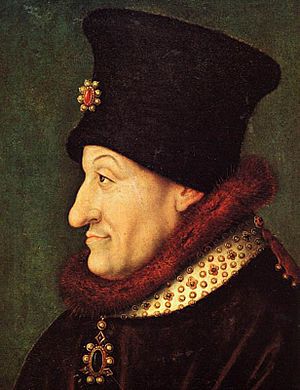
In 1361, the Duke of Burgundy died without children. The French king, John II of France, then gave the Duchy of Burgundy to his youngest son, Philip the Bold. Philip became Duke of Burgundy in 1364.
Philip then made an important marriage. He married Margaret of Flanders in 1369. Margaret was the heir to many rich lands, including Flanders, Artois, and the Free County of Burgundy. When her father died in 1384, Philip became the ruler of all these territories. This greatly expanded the lands under Burgundian control.
Philip also started to bring these lands together. He combined the offices of Chancellor of Burgundy and Flanders. He also created two "Chambers of Accounts" to manage money. One was in Lille for his northern lands, and one in Dijon for his southern lands. These steps helped centralize power.
From French Allies to Rivals
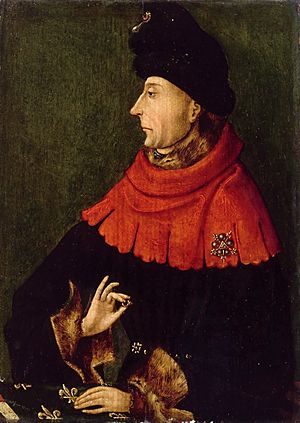
Philip the Bold and his son, John the Fearless, were loyal to the French king at first. Philip even helped rule France when King Charles VI was young. Later, Charles VI became mentally ill. This gave the Duke of Burgundy more power.
John the Fearless took over in 1404. He wanted more power in France. He had his rival, Louis I, Duke of Orléans, killed in 1407. This started a civil war in France.
When England restarted the Hundred Years' War, John stayed neutral. This meant his army was not defeated at the Battle of Agincourt. In 1419, John was killed during a meeting with the French prince, Charles.
Philip the Good and English Alliance
After his father's murder, Philip the Good became duke. He was only 23. To get revenge, he allied with the English. He made the French king sign a treaty that disinherited his own son. Instead, the English king, Henry V of England, was to become the next king of France.
However, both Henry V and the French king died soon after. The English and Burgundians still controlled much of France. But then Joan of Arc helped the French prince, Charles VII, become king. Joan of Arc was later captured by the Burgundians and given to the English.
In 1435, Philip the Good made peace with France. He recognized Charles VII as the King of France. In return, Charles recognized Burgundy's new lands. Philip was also excused from having to pay homage to the French king.
How did the Burgundian State grow?
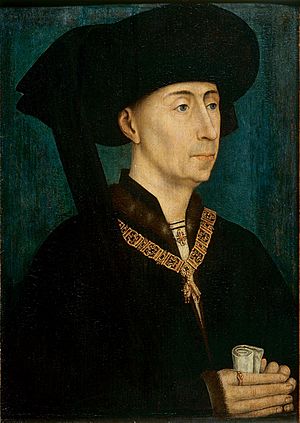
After 1435, Philip the Good focused on his own territories. He greatly expanded the Burgundian State in the Low Countries. He bought or inherited many lands, including Namur, Brabant, Limburg, Luxembourg, Hainaut, Holland, and Zeeland. This united the Low Countries under Burgundian rule. They became known as the Burgundian Netherlands.
Under Philip, the Burgundian court became very grand. He was a great supporter of art. The court was famous for its parties and celebrations. Philip also created the important Order of the Golden Fleece.
However, the cities in Flanders did not like the duke's growing power. They were proud of their freedom. Philip had to put down rebellions in Bruges and Ghent. The people of Liège also rebelled against Burgundian control several times.
Charles the Bold's Dream of a Kingdom

Charles the Bold became duke in 1467. He was very ambitious. He wanted to create a continuous, independent kingdom. He dreamed of bringing back the old kingdom of Lotharingia.
Charles tried to make his lands independent from France. He also tried to get the Holy Roman Emperor to make him a king. In 1473, the Emperor even prepared a crown for Charles. But the Emperor suddenly left without crowning him.
Charles kept expanding his lands. He bought territories and conquered the Duchy of Guelders and the Duchy of Lorraine. By 1475, he ruled a large, continuous territory. He wanted to make Nancy the capital of his new kingdom.
Charles was obsessed with becoming a king. He dressed richly and acted like an equal to kings and emperors. He even had a golden hat that looked like a crown.
However, Charles's expansion made the Swiss nervous. This led to the Burgundian Wars. Charles's armies lost two big battles in 1476. The Duke of Lorraine then took back Nancy. Charles tried to retake Nancy quickly. But his weakened army was defeated in the Battle of Nancy in 1477. Charles the Bold was killed in this battle.
What happened after Charles the Bold's death?
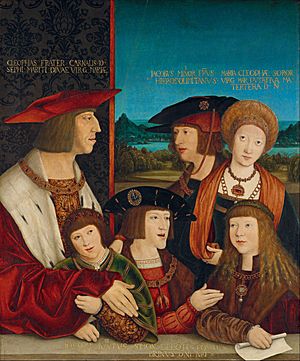
After Charles's death, the French king quickly invaded Burgundy. Charles's only heir was his daughter, Mary. To protect her lands, Mary agreed to give more power back to the local people. She also married Maximilian of Austria in 1477. This marriage brought the powerful Habsburg family into the picture.
Mary died unexpectedly in 1482. This weakened Maximilian's position. A treaty was signed in 1482, dividing the Burgundian lands. France got the Duchy of Burgundy, Artois, and Picardy. The Habsburgs kept Flanders and the rest of the Netherlands.
Later, more treaties changed these borders. By 1529, France gave up its claim to Flanders and Artois. In return, the Holy Roman Emperor gave up his claim to the Duchy of Burgundy.
In 1512, the Burgundian Circle was created. This was a group of territories within the Holy Roman Empire. More lands were added over time, forming the Seventeen Provinces. These lands later split during the Dutch Revolt. The northern parts became the independent United Provinces. The southern parts remained under Spanish rule and became the Spanish Netherlands.
Today, the former Burgundian territories are divided between France, the Netherlands, and modern-day Belgium.
How was the Burgundian State governed?
The Court
The Burgundian court did not have one fixed capital city. The dukes traveled between towns like Brussels, Ghent, and Lille in the Netherlands. Dijon was the traditional capital of the Duchy of Burgundy.
The court was known for its amazing wealth and splendor. The wedding of Charles the Bold and Margaret of York was a huge, famous event. The chapters of the Order of the Golden Fleece were also grand celebrations. This order promoted chivalry and Christianity.
The Burgundian court was also a major center for art. Famous artists like Jan van Eyck and composers like Guillaume Du Fay worked there. They created beautiful illustrated manuscripts, paintings, and music.
Politics and Justice
The Burgundian lands were generally split into two main parts: Burgundy in the south and the Burgundian Netherlands in the north. The States General of the Netherlands was a meeting of representatives from the different provinces. It was first called in 1464.
The Chancellor of Burgundy became a very important political figure. He acted as a chief minister for the dukes. Nicolas Rolin was a famous chancellor for Philip the Good.
For justice, Philip the Bold created a Parliament in Beaune. In 1473, Charles the Bold created a new high court in Mechelen. This court heard appeals from all over the Burgundian Netherlands. It was meant to be a sovereign court, meaning its decisions were final.
Military and Money
The Burgundian army gathered soldiers from all its provinces. Charles the Bold modernized the army. He created a regular army based on the French model.
The "Chambers of Accounts" were important for managing money. Philip the Bold created chambers in Lille and Dijon. Philip the Good added chambers in Brussels and The Hague. These helped centralize the financial system.
Taxes were mainly indirect at first. But as military campaigns became more expensive, the dukes asked for more and more money.
What were the symbols of Valois Burgundy?
- The dukes' coat of arms changed over time. It combined the arms of Burgundy with those of other lands they acquired, like Flanders and Brabant.
- John the Fearless used a plane (a tool) as his personal symbol.
- The Cross of Burgundy was a very important symbol. It was a diagonal, X-shaped cross, often red. Later, it was shown as two wooden branches with saw-like edges.
- A firesteel (a tool for making fire) with the letter B was another Burgundian symbol. It was often shown with sparks.
- The Golden Fleece symbol was also often seen. It was part of the collar worn by members of the Order.
The Dukes of Burgundy
| Picture | Name | Birth | Reign | Notes | Arms |
|---|---|---|---|---|---|
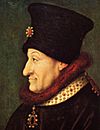 |
Philip the Bold (Philippe le Hardi) (Filips de Stoute) |
15 January 1342 | 6 September 1363 – 27 April 1404 | Youngest son of John II of France. Became duke of Burgundy in 1363. Married Margaret of Flanders in 1369. |  |
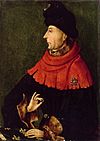 |
John the Fearless (Jean sans Peur) (Jan zonder Vrees) |
28 May 1371 | 27 April 1404 – 10 September 1419 | Eldest son of Philip the Bold. Was killed at Montereau in 1419. |  |
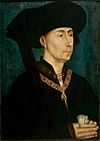 |
Philip the Good (Philippe le Bon) (Filips de Goede) |
31 July 1396 | 10 September 1419 – 15 June 1467 | Eldest son of John the Fearless. |  |
 |
Charles the Bold (Charles le Téméraire) (Karel de Stoute) |
21 November 1433 | 15 June 1467 – 5 January 1477 | Only legitimate son of Philip the Good. Killed at the battle of Nancy. |  |
 |
Mary of Burgundy (Marie de Bourgogne) (Maria van Bourgondië) |
13 February 1457 | 5 January 1477 – 27 March 1482 | Only child of Charles the Bold. Married Maximilian of Austria in 1477. |  |
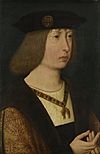 |
Philip the Handsome (Philippe le Beau) (Filips de Schone) |
22 July 1478 | 27 March 1482 – 25 September 1506 | Eldest son of Duchess Mary. His father Maximilian was regent until 1494. Married Joanna of Castille in 1496. |  |
 |
Charles V (Charles Quint) (Karel V) |
24 February 1500 | 25 September 1506 – 25 October 1555 | Eldest son of Philip the Handsome. Became Emperor of the Romans in 1519. |  |
See also
 In Spanish: Estado borgoñón para niños
In Spanish: Estado borgoñón para niños





